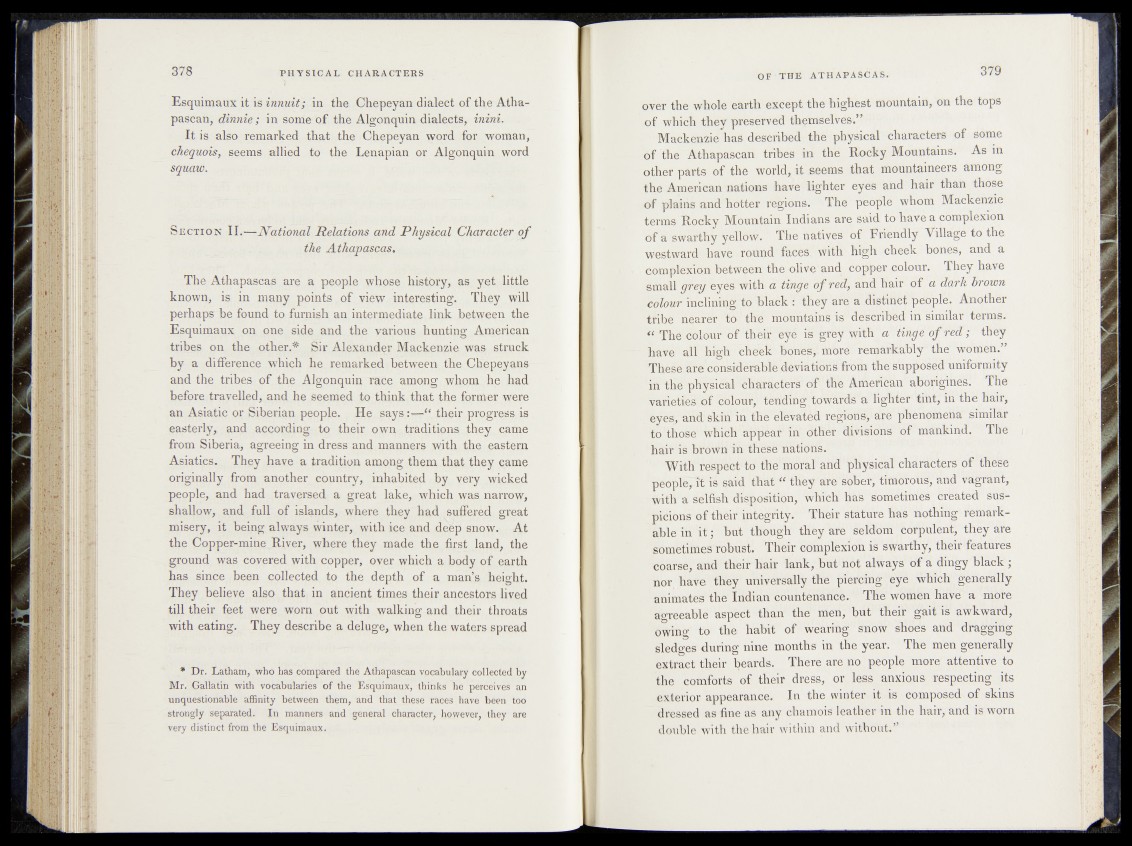
Esquimaux it is innuit; in the Chepeyan dialect of the Athapascan,
dinnie; in some of the Algonquin dialects, inini.
It is also remarked that the Chepeyan word for woman,
chequois, seems allied to the Lenapian or Algonquin word
squaw.
S e c t io n II.—National Relations and Physical Character o f
the Athapascas,
The Athapascas are a people whose histbry, as yet little
known, is in many points, of view interesting, They will
perhaps be found to furnish an intermediate link between the
Esquimaux on one side and the various hunting American
tribes on the other.* Sir Alexandf$ Mackenzie was struck
by a difference which he remarked between the. Chepeyans
and the tribes of the Algonquin lace among whom he had
before travelled, and he seemed to think that the former .v^ere
an Asiatic or Siberian people. He says:—“ their progress is
easterly, and according to their own traditions they came
from Siberia, agreeing in dress and manners with the eastern
Asiatics. They have a tradition among them that they came
originally from another country, inhabited by very wicked
people, and had traversed a great lake, which was narrow,
shallow, and full of islands, where they had suffered great
misery, it being always winter, with ice and de£p snow.- At
the Copper-mine River, where they made the first land, the
ground was covered with copper, over which a body of earth
has since been collected to the depth of a man’s height.
They believe also that in ancient times their ancestors lived
till their feet were worn out with walking and their throats
with eating. They describe a deluge, when the waters spread
* Dr. Latham, who has compared the Athapascan vocabulary collected by
Mr. Gallatin with vocabularies of the Esquimaux, thinks he perceives an
unquestionable affinity between them, and that these races have been too
strongly separated. In manners and general character, however, they are
very distinct from the Esquimaux.
over the whole earth except the highest mountain, on the tops
of which they preserved themselves.” •
Mackenzie has described the physical characters of some
of the Athapascan tribes "in the Rocky Mountains. As in
other parts of the world, it seems that mountaineers among
the American nations have lighter eyes and hair than those
of plains and hotter regions. The people whom Mackenzie
terms Rocky Mountain Indians are said to'have a complexion
of a swarthy ÿetïBw^ The natives of Friendly Village to the
westward have round faces,, with high eheek bones, and a
complexion between the olive'and copper colour. They have
imdXYgrey eyes with- a tinge ofred\ and hair of a darh brown
colour inclining to black : they are adisrihbt people. Another
tribe nearer to the mountains is^e^ib ecPm 'Sîbîilar terms.
“ Thé cölour of their;‘efe is Irfe'^hvith a'tinge"of red ; they
have all high“'cheek bónes,.mbré' remarkably*’ the women.”
ThèSe,are con'sidëTablh,dèviatiö'hs fröm the"supposed uniformity
in the physical characters of the American aborigines; The
vàrietfés of colour, tending'towards' a lighter;* tint, in the hair,
and skin in the elevatèd regibris,;hre phènomena’ similar
fd ’thêhé Which appear1 îff other division^ of mankind. The
hair is brown in thësë fiatibns.
With res'pèctdo* the' moral and physical characters of these
people^it is said that “ they are’Sober, tirn%fotis’, and vagrant,
with a êëlfish disposition, which has sometimes ^ created suspicions
of their integrity. ' Their stature has nothing' remarkable
in it ; but though they are s’eldom corpulent, they are
sometimes robust. Their complexion is" swarthy, their features
coarse, and their hair lank, but not alwaysi Jof a dingy black ;
nor have they universally the piercing êÿë which generally
animates the Indian countehaóCfe. The women have a more
agreeable aspect than the men, but their gait is awkward,
owing to the habit of wearing snöW sfiöès and dragging
sledges during nine months in the year. The men generally
extract their beards. There are no people more attentive to
the comforts of their dress, or less anxious; respecting its
exterior appearance* In the .winter it is composed of skins
dressed as fine as any chamois leather in the hair, and is worn
double with the hair within and without.”